| Current Issue : web |
| Current Issue : PDF |
| features |
| Silver Creek Seasons |
| Land of No Return |
| Sawtooth Survival |
| A Coach's Calling |
| departments |
| Joe Fos |
| Idaho's Dixie Land |
| An Herbal Life |
| A Griffon's Tale |
| Chef's Specialty |
| Valley Interview |
| calendar |
| Fall 2006 |
| listings |
| Galleries |
| Dining |
| Lodging |
| maps |
| Dining Map |
| Gallery Map |
| the guide |
| Last Summer |
| Editorial Submission |
| Calendar Submission |
| Advertising Submission |
| Advertising Rates |
| About Us |
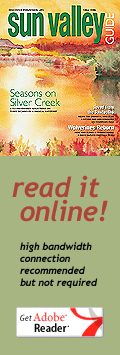
|
|
Copyright © 2006 Express Publishing Inc. All Rights reserved. Reproduction in whole or in part in any form or medium without express written permission of Express Publishing Inc. is strictly prohibited. The Sun Valley Guide magazine is distributed free three times a year to residents and guests throughout the Sun Valley, Idaho resort area communities. Subscribers to the Idaho Mountain Express newspaper will receive the Sun Valley Guide with their subscription. |

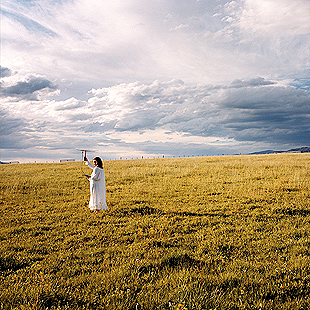
photo by Laura McPhee
A Land
of
No Return?
East Coast photographer Laura McPhee spent two years discovering the beauty, cruelty and universality of the Sawtooth Valley. Words by Jennifer Tuohy. Photos by Laura McPhee.
Jagged peaks of
the Sawtooth Mountains cup wide-open spaces of a valley ripped in two by
the tumbling Salmon River, the River of No Return.
Such sweeping grandeur, to be found in the valley to our north, embodies the myth of the West. Or so Boston photographer Laura McPhee discovered as she sought to unmask that myth during a two-year artist’s residency in the Sawtooth Valley. What the East Coast native discovered, and the work she produced, surprised her and poses thought-provoking questions to those both familiar and unfamiliar with the American West.
Capturing the
spirit of the West
Through the lens of McPhee’s old-fashioned Deardorff viewfinder camera,
the Sawtooth Valley—which lies in Blaine and Custer counties—became
representative of America as a whole, of the plight communities nationwide
face when dealing with land issues.
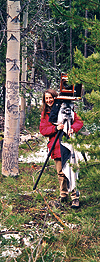 Lying in
the heart of Idaho, the valley holds all the ingredients of a good
land-use debate: the Salmon River—key to the survival of certain species
of salmon; spectacular jagged peaks; an infected forest; recreation,
spanning from quiet cross-country skiing to loud jet boats and
snowmobiles; logging, mining and ranching industries; remoteness; sparse
population and, of course, the juxtaposition of public and private land.
Lying in
the heart of Idaho, the valley holds all the ingredients of a good
land-use debate: the Salmon River—key to the survival of certain species
of salmon; spectacular jagged peaks; an infected forest; recreation,
spanning from quiet cross-country skiing to loud jet boats and
snowmobiles; logging, mining and ranching industries; remoteness; sparse
population and, of course, the juxtaposition of public and private land.
“It has all of the issues there,” said McPhee. “How do we preserve? What are we preserving? How much do we try to preserve and how much are we trying to get things for our own personal interest? How much do we develop and how much do we leave green? I think that there are very real both cultural and natural issues being played out in the West.The West is the stage on which we can watch those things happening.”
McPhee became quickly enraptured by the scope of this scenic valley. “In such an idyllic place, with so few people, there are still so many areas where people are at odds with one another about nature and what should happen in that place.”
But how was she to convey this impasse in still images?
Soon after she arrived in the valley, in the summer of 2003, she started to fill the pages of her notebook with the valley’s stories, ranging from the reintroduction of wolves to the sad tale of the endangered sockeye salmon. As she talks about their story—whose journey to the valley has become so difficult due to human intervention that last year no sockeye returned from the ocean via the Salmon River—her voice becomes agitated and the sound of her feet pacing across the floor of her Brookline, Mass. home echoes down the phone lines. “You tend to think they are wild animals there. But what is wild?” she asks. “The wolves are reintroduced. The elk are kept at a certain level for hunting—even they had to be reintroduced at a certain point. It’s very complicated how you think about those things.”
And therein lay McPhee’s personal dilemma. During the time she spent in the Sawtooth Valley, she tried hard to remain an impartial observer, aware that her own prejudices and East Coast upbringing made her spectacularly ill-equipped to pass judgment on the land she was chronicling. “I tried to remain neutral. But what I found fascinating was the complexity of the situation.”
Nature versus
culture
It is McPhee’s innate naiveté when confronted with the Wild West that
makes her work so important. Forty of McPhee’s large-scale (8-foot by
6-foot) images of moments of life in the Sawtooth Valley hang in the
Museum of Fine Arts, Boston. McPhee’s first major solo museum exhibition
is titled Laura McPhee: River of No Return. It opened in May and
remains on display through September. “The results might make you weep
with their sheer beauty,” exclaimed Boston Globe correspondent Cate
McQuaid.
 What McPhee
learned from her time in this remote corner of one of America’s most
remote states will, hopefully, translate to her East Coast audience.
“These large and remarkable photographs reveal both the jarring reality
and the tentative serenity of America,” said William Stover, assistant
curator of contemporary art at the Museum of Fine Arts and curator of
McPhee’s exhibition. “The dilemma between nature and culture is one that
is eternally complex. Laura’s photographs successfully illustrate this
contested relationship within the context of one group of people living in
a remote area.”
What McPhee
learned from her time in this remote corner of one of America’s most
remote states will, hopefully, translate to her East Coast audience.
“These large and remarkable photographs reveal both the jarring reality
and the tentative serenity of America,” said William Stover, assistant
curator of contemporary art at the Museum of Fine Arts and curator of
McPhee’s exhibition. “The dilemma between nature and culture is one that
is eternally complex. Laura’s photographs successfully illustrate this
contested relationship within the context of one group of people living in
a remote area.”
McPhee and Stover assert the work presents many arguments and dilemmas, but purposefully does not answer them. “I think that things evolve, that there are no real resolutions or solutions to things,” said McPhee. “Like the Valley Road Fire (a 40,000-acre forest fire that McPhee witnessed in the summer of 2005). It happens and then you deal with what is happening; you can’t fix it in advance even if you would like to. My desire is for people to think about things and to feel things, more than to try and be didactic and to teach them something. I’d rather that (my work) stimulate their way of thinking. Part of why I take so much pleasure in my work is that it challenges my own prejudices and assumptions and forces me to think differently and to learn things. I would hope that my work could translate that experience.”
McPhee admits to having many prejudices about the West before arriving in the valley. “I had prejudices about guns. I come from a state where guns are practically disallowed and for obvious reasons, because people kill each other. (In the Sawtooth Valley) guns are a totally different thing. It’s about hunting.”
Although raised on a New Jersey farm, McPhee had no experience with hunting. “I’m used to buying meat in Styrofoam packages. I found (hunting) to be one of the most beautiful experiences of my life.” McPhee admits that it’s difficult to reconcile the hypocrisy some people indulge in when they hear about hunting or see dead animals and think “yuck” with being someone who eats meat from those Styrofoam packages in the supermarket. In reality, agreed McPhee, the hunters are the ones doing it the “right” way. “I really, really came to that and felt strongly.”
Returning to the
River of no Return
At 47, McPhee is one of Boston’s most distinguished fine art
photographers. She has held Guggenheim and Fulbright fellowships, and her
work is in the permanent collections of New York’s Metropolitan Museum of
Art, the J. Paul Getty Museum in Los Angeles, the San Francisco Museum of
Modern Art and the Los Angeles County Museum of Art. She also teaches at
Massachusetts College of Art.
McPhee’s father, John McPhee, is a renowned author and New Yorker writer, but it is from her mother that she inherited a passion for creativity. Pryde Brown, also a photographer, gave her daughter a 120mm camera when she was 12 and from there, McPhee’s path was clear.
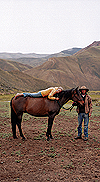 When she
arrived in the Sawtooth Valley, however, McPhee was desperately unsure of
that path. “I wasn’t sure what I would be doing there. I really didn’t
know. Taking on the West, it’s so mythic and iconic. Standing up on
Galena, looking at the classic Western mountains, you think, ‘Oh my God.
What am I going to do with this?’ It’s such a huge subject and so I felt
very challenged by it.”
When she
arrived in the Sawtooth Valley, however, McPhee was desperately unsure of
that path. “I wasn’t sure what I would be doing there. I really didn’t
know. Taking on the West, it’s so mythic and iconic. Standing up on
Galena, looking at the classic Western mountains, you think, ‘Oh my God.
What am I going to do with this?’ It’s such a huge subject and so I felt
very challenged by it.”
McPhee found herself in the valley by way of the somewhat mysterious Alturas Foundation. Named after a lake in the Sawtooth Valley, this family foundation—representing four generations in the American West—is dedicated to visual arts and American culture. In 2003, the foundation selected McPhee to be its first artist-in-residence.
Although she was initially overwhelmed by the magnitude of her subject, those first impressions set the tone for what McPhee describes as work she has been preparing all of her life to make.
When she arrived at the top of Galena Pass her thoughts traveled to her grandmother. Raised by a divorced Ohio schoolteacher, she grew up in the early part of the twentieth century, traveling across the West with her mother and sister, living a subsistence life in rudimentary log cabins. “I stood on Galena and I thought about her passing from one mining town to another as a child. And for me that was the hook, an emotional, autobiographical hook. Of course,” McPhee continued with a laugh, “she didn’t arrive there in a white Suburban.”
With thoughts of her late grandmother floating around in her head, McPhee traveled down to the valley floor (in a white Suburban). “The first thing I saw was the sign that says, ‘Headwaters: River of No Return.’ And it struck me, that’s it. Somebody’s experience passes away and passes forward and you never really know exactly what it was like to stand in that person’s shoes or to have that experience, so it’s always an approximation of that. That’s how you understand someone else’s subjective experience or history. So for me, that name really stuck.”
And, with her body of work now hanging in downtown Boston, McPee has captured and relayed a subjective experience—the essence of life as it was in a moment in the life of the Sawtooth Valley. Objectively and without guile, McPhee chronicled an experience of life in that great, remote landscape that, without her, could have washed unnoticed downriver and into the ocean, never to return.
Making
Mattie
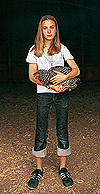 The dominant human subject of McPhee’s exhibition, River of No Return, is
a teenage girl named Mattie. When McPhee met Mattie and her family, they
were living year-round in the Sawtooth Valley, home-schooling Mattie.
The dominant human subject of McPhee’s exhibition, River of No Return, is
a teenage girl named Mattie. When McPhee met Mattie and her family, they
were living year-round in the Sawtooth Valley, home-schooling Mattie.
“I came upon Mattie when she was 12, and so I finished when she was 14,” said McPhee. “That’s a big passage, and I think you can feel that in the pictures.
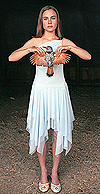 “(Her
family) was taking on the whole idea of living someplace where there
weren’t a lot of the conveniences that most of us city dwellers, or even
Ketchum dwellers, are familiar with. They were choosing to live under a
snow bank for several months a year. Cope with blizzards, raise chickens
and hunt to eat and so forth.”
“(Her
family) was taking on the whole idea of living someplace where there
weren’t a lot of the conveniences that most of us city dwellers, or even
Ketchum dwellers, are familiar with. They were choosing to live under a
snow bank for several months a year. Cope with blizzards, raise chickens
and hunt to eat and so forth.”
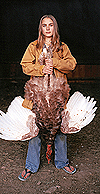 McPhee made
a series of images of Mattie standing in the doorway of the family’s barn.
Art critic Cate McQuaid of the Boston Globe wrote of these central images,
“Both gangly and graceful, Mattie embodies a tension between free-spirited
girl and adolescent trying to shape herself to society’s demands. Seeing
Mattie in jeans holding a speckled hen with hands that look as oversized
as a puppy’s paws, and then seeing her in an eighth-grade graduation
dress, as beguiling and mysterious as a young Audrey Hepburn, is
bittersweet, as is the passage from childhood to adulthood.”
McPhee made
a series of images of Mattie standing in the doorway of the family’s barn.
Art critic Cate McQuaid of the Boston Globe wrote of these central images,
“Both gangly and graceful, Mattie embodies a tension between free-spirited
girl and adolescent trying to shape herself to society’s demands. Seeing
Mattie in jeans holding a speckled hen with hands that look as oversized
as a puppy’s paws, and then seeing her in an eighth-grade graduation
dress, as beguiling and mysterious as a young Audrey Hepburn, is
bittersweet, as is the passage from childhood to adulthood.”
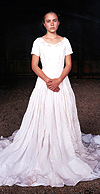 “I realized
later that in some ways Mattie is representative both of the past and of
the future,” said McPhee. “That was one of the interesting things about
being in the valley… that you could look at the past, and the idea of what
it would have been like for my grandmother. But that you could also think
about the future and about what would happen to nature in the future and
to a place like that. Mattie embodied that for me. That she could at once
represent a girl who could have grown up in the nineteenth century and
also be, very much, a twenty-first century girl.”
“I realized
later that in some ways Mattie is representative both of the past and of
the future,” said McPhee. “That was one of the interesting things about
being in the valley… that you could look at the past, and the idea of what
it would have been like for my grandmother. But that you could also think
about the future and about what would happen to nature in the future and
to a place like that. Mattie embodied that for me. That she could at once
represent a girl who could have grown up in the nineteenth century and
also be, very much, a twenty-first century girl.”
Laura
McPhee: River of No Return is on display at the Museum of Fine Arts,
Boston in Massachusetts through September. All photographs reproduced
are by Laura McPhee. Made available courtesy of The Alturas Foundation;
Bernard Toale Gallery, Boston, and Bonni Benrubi Gallery, New York.
© Laura McPhee. Courtesy, Museum of Fine Arts, Boston